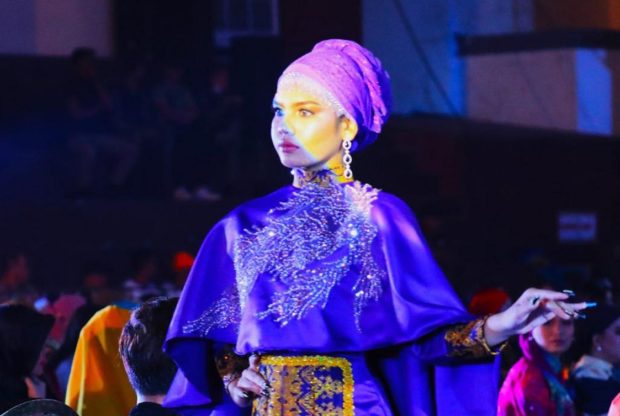Bangsamoro people remember arrival of Islam in Mindanao

PRIDE | The recent Shariff Kabunsuan festival also showcased the “inaul,” a traditional Maguindanao fabric that is a symbol of pride and dignity. (Photo courtesy of. the Bangsamoro Information Office)
COTABATO CITY, Northern Maguindanao, Philippines — The Bangsamoro people held a weeklong festival to commemorate the arrival in Mindanao some 500 years ago of Arab-Malay missionary Shariff Kabunsuan of Johor who would spread Islam in the region and build the sultanate of Maguindanao.
Boats decorated with colorful, glaring garlands and boarded by Islamic missionaries sailed along the rivers in Barangay Kalangan 2 on Monday for the Guinakit fluvial parade, in a reenactment of Kabunsuan’s arrival via the Rio Grande de Mindanao.
“This is a celebration of Bangsamoro identity,” said interim Chief Minister Ahod “Al Haj Murad” Ebrahim of the Bangsamoro Autonomous Region in Muslim Mindanao (BARMM).
Kalangan is thought to be the exact same spot where Kabunsuan disembarked from his voyage and first set foot in Mindanao. Apart from preaching Islam, Kabunsuan would establish a sultanate sometime in 1520 which he ruled for over 20 years.
It was the first time that Ebrahim, an erstwhile rebel leader, personally witnessed the celebration as it was also the first time for the Cotabato City government to jointly participate with the BARMM in rolling out the grand event.
Article continues after this advertisement“I am very happy that after the struggle of the Bangsamoro, I am here with you celebrating this most important celebration of our generations,” Ebrahim said.
Article continues after this advertisement“This creative and meaningful ceremony is a symbol of the past journey and adventure of those who lived before us and left civilized and progressive communities and rich cultures that we take pride in and cherish until now,” he added.
“This day is the most important day for the Bangsamoro people as it marks the formation of our identity as Bangsamoro in this part of the country. Without the coming of Shariff Kabunsuan, Bangsamoro will never exist,” Ebrahim said.
Peace, unity
Cotabato City Mayor Bruce Matabalao said the explosion of colors during the festivities should be taken for its message of peace and unity despite diversity.
“More than the display of this colorful bancas (motorboat), this celebration symbolizes strong Islamic faith in Mindanao at the same time respecting and living side by side with peoples of various faiths, culture and tradition,” Matabalao said in Magindanawn.
The festival traditionally draws thousands of spectators, especially during the culminating fluvial parade. This year’s festival theme was “One Heritage, One Culture, Endless Possibilities.”
It showcased arts, rich culture and tradition, local cuisine, and the people of the Bangsamoro region.
A “grand pagana” (thanksgiving) at the Cotabato City Hall on Monday hosted by Matabalao ended the festival.
During the celebration, the famous Bangsamoro fabric “inaul,” or “inawl,” was prominently featured with a fashion show highlighting local designers’ creations using it.
Themed “Weaving the beautiful pattern of peace and prosperity for our people,” the show exhibited the Bangsamoro culture, vibrant weaving tradition, and the history of a great civilization that continue to stand with pride and dignity amid the inroads of dominant global cultures.
According to former Maguindanao Rep. Bai Sandra Sema, who is now Cotabato City Tourism Council chair, the inaul cloth is a heritage that should be preserved and deserves to be recognized nationally.
“We are working to push inaul to become a national fabric,” Sema said. “If we are talking about unity, if we are to talk about solidarity, the Philippines must recognize inaul as the national fabric.”
Inaul is a Maguindanaon term meaning woven, which symbolizes strength as it is made to last. Inaul was a status symbol worn with pride and respect.
Traditional leaders and elders said if inaul was given as a gift, it was a way of wishing the recipient prosperity for a lifetime.